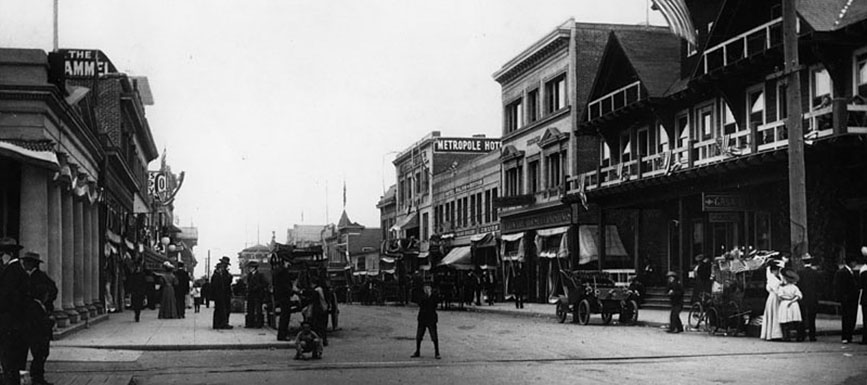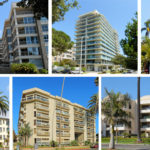Santa Monica – The City by the Sea
Santa Monica CA has been described as the “City by the Sea,” “Pear of the Pacific,” “City of Inspiration” and “Jewel of the Sunset Bay. The city was just a dream to the settlers passing through during the gold rush days of 1849. Many believed a town on the bay was sure to grow into a thriving, prosperous region, and possibly “the greatest commercial centers of the southwest.” By 1875 the town site was created and the first lots were on the auction block, selling for $75.00 to $500.00. Bidders at the auction were so excited by the description provided by the auctioneer: Jan Loomis’ book Westside Chronicles, Historic Stories of West Los Angeles details the rich history that most of us haven’t imagined, and shares what must be the most poetic offering of real estate ever written – “At one o’clock we will sell at public outcry to the highest bidder the Pacific Ocean, draped with a western sky of scarlet and gold; we will sell a bay filled with white winged ships; we will sell a southern horizon, rimmed with a choice collection of purple mountains carved in castles and turrets and domes; we will sell a frostless, bracing, warm yet unlangured air braided in and out with sunshine and odored with the breath of flowers.” Who could resist that sales pitch?
Electric trolleys began running in 1896, linking Santa Monica CA to Los Angeles and stimulating growth. New residential subdivisions sprang up and the town of Ocean Park became part of Santa Monica. The northern area of Santa Monica CA, the “Gold Coast,” became a renowned resort for the rich and famous. From 1909 to 1919, road races that began on Ocean Avenue were watched by thousands of people. These races and tennis put Santa Monica CA in the national limelight, but it was the first round-the-world flight with Donald Douglas World Cruisers in 1924 that put Santa Monica CA on the map. From the beginning, Santa Monica CA has been known as a place of leisure and year-round fun, for residents and tourists alike. Saying that the original buyers made a good choice would be the understatement of the century. Today, the mountains, canyons, ocean and a sunny climate continue to enthrall homeowners and as predicted has become the mecca of Southern California. The housing industry continues to thrive and after almost two hundred years.
Santa Monica CA Architecture
Southern California has always been at the forefront on residential home design and is comprised of architectural styles ranging from Case Study Houses to Streamline Moderne. The Santa Monica Conservancy offers downtown walking tours, exploring the area’s diverse architectural heritage. Some of the buildings include the Majestic Theater, The Keller Block, and the Builders Exchange. The Case Study Houses, designed between the mid-1940s and mid-1960s are particularly characteristic of the Los Angeles area. These model homes were intended to be reasonably affordable and easy to construct from readily available new materials for post-World War II families. Arts & Architecture Magazine commissioned 36 houses and apartment buildings were created by some of the most celebrated architects and designers of the time, including names like Neutra, Eames, Koenic, Stahl and Saarinen. About 20 of these buildings still stand and most are still private residences. The Eames and Stahl Houses, the two most famous Case Study Houses, are sometimes open to visitors. Curbed LA Magazine published an informative list with details of these houses.
Los Angeles grew very rapidly in the decades before the twentieth century. During that time, the garden apartment originated an evolution of the bungalow court. The bungalow court is a style of multi-family housing which features several small houses arranged around a central garden and was popular prior to World War II. These homes were designed in a variety of architectural styles, including Spanish Colonial Revival. According to the Santa Monica CA Conservancy, the City Council designated the iconic courtyard housing on San Vicente Boulevard from Seventh Street west as a historic district in 2015. It is the first new historic district in fifteen years and is the third historic district in Santa Monica, joining the Third Street Neighborhood District and the Bay Street Craftsman Cluster.
Historical Landmarks in Santa Monica CA
Many homes in Santa Monica CA are considered historical landmarks today. The Historical Site Committee was formed in 1975 in response to increased development pressures during the 1960s and 1970 and today includes a comprehensive preservation program. A historic resource is a building, structure, site, object, district, or landscape that may be associated with historic events or associated with important historical persons. It may also represent a rare type of historic property or has architectural quality or importance. Landmarks, according the Santa Monica City website, are considered to have the highest level of individual historical or architectural significance. Therefore, along with contributing buildings located within historic districts, Landmarks are offered the highest protection with respect to alterations and demolitions. A National Historic Landmark can only be designated by the Secretary of the Interior. Santa Monica CA currently has over 400 residential properties listed as historical and 60 properties have been designated landmarks by the city.
One example of a landmark property is John Byer’s Office that is located at 246 26th Street. It was built in 1926, in the period between World War I and World War II. John Winford Byers was an architect who designed dozens of homes in Brentwood, Pacific Palisades and Santa Monica. According to an article in the Santa Monica Mirror, he explored numerous styles, including Spanish, Mexican, and Monterey, and Adobe. In fact, Byers was a leader in using adobe as a building material. He told the Los Angeles Times on May 17, 1931, “Buildings of adobe are replete with a delicate and elusive charm and there in an easy plasticity about the material that makes it particularly suitable to the Spanish or California type of architecture.” John Byers designed a residence located at 506 Adelaide Drive in 1923. The property has been remodeled many times taking on styles from Craftsman to Mediterranean. This property is designated as a structure of merit, but not a landmark.
Just west of the property located on Adelaide Drive are the infamous “Stairs”. There are two sets of stairs on Adelaide Drive, one wooden and one concrete, that continue to be utilized, but now more for exercise than for true transportation. There are many staircases throughout Los Angeles remind us of the time the area wasn’t congested with cars. We Like LA shares a list of 10 secret and not-so secret staircases and explains how they were used as modes of crossings and connections for pedestrians across the city. Nowadays, the remaining stairs around the city are used as workout alternative to gyms. The wooden staircase called “99 Steps” was constructed in 1875 at the end of Arizona Avenue to allow easy access to the beach; a staircase and a bridge over the Pacific Coast Highway can be found in its place today.
Transportation in Santa Monica CA
As Guyot writes in the We Like LA article, Los Angeles was once a city connected by public transportation in the form of trolleys, buses and trains. Today we have a lot of cars and we still have busses. The train and trolley has been replaced with the The Expo Line Light Rail, scheduled to open in May of 2016. It will provide the first passenger train service to Santa Monica CA in 63 years. Horse-drawn wagons used to haul freight up the California Incline after cliffs were scaled back to allow for road construction. Today, Santa Monica CA has one of the most extensive transit networks for a city of its size. The city continues to develop ways to preserve and protect its neighborhoods and historical landmarks while providing access to commercial areas. Pedestrians, bicycles, motorists, and transit riders all have options.
Our transportation continues to change and evolve and our housing does the same; the two are inextricably linked. Yet, Santa Monica CA is full of architectural gems that remind us of our past and beautifully display the evolution of style. The growth and success of a city is very often determined by how transportation supports the preservation of its historical landmarks and commercial centers at the same time. For example, according to the Santa Monica Conservancy, Third Street was converted into a pedestrian mall in 1965 in an attempt to revitalize the fading retail sector, but its urban design plan did not bring shoppers back. he Santa Monica Freeway was completed in 1966 and brought the promise of prosperity, but in fact, it dispersed consumers away to outlying shopping centers. Then, Santa Monica Place, an enclosed mall designed by Frank Gehry, was constructed as a redevelopment project in 1980. In order to revitalize the failing pedestrian mall, Santa Monica redesigned it to incorporate a mix of entertainment, restaurants and retail. Today the vibrant Third Street Promenade is a huge success and a model for cities everywhere. As the city and community continues to evolve, Santa Monica CA remains dedicated to preserving it’s rich heritage.
Please contact our office for more information on the Santa Monica real estate market, available listings and consultation on successfully navigating this market.



